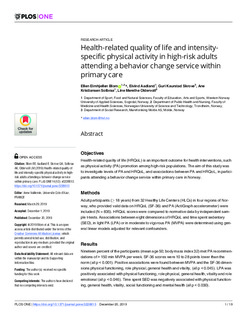| dc.contributor.author | Blom, Ellen Eimhjellen | |
| dc.contributor.author | Aadland, Eivind | |
| dc.contributor.author | Skrove, Guri Kaurstad | |
| dc.contributor.author | Solbraa, Ane Kristiansen | |
| dc.contributor.author | Oldervoll, Line Merethe | |
| dc.date.accessioned | 2020-01-31T13:22:34Z | |
| dc.date.available | 2020-01-31T13:22:34Z | |
| dc.date.created | 2020-01-08T18:25:53Z | |
| dc.date.issued | 2019 | |
| dc.identifier.citation | Blom, E. E., Aadland, E., Skrove, G. K., Solbraa, A. K., & Oldervoll, L. M. (2019). Health-related quality of life and intensity-specific physical activity in high-risk adults attending a behavior change service within primary care. Plos One, 14(12). | nb_NO |
| dc.identifier.issn | 1932-6203 | |
| dc.identifier.uri | http://hdl.handle.net/11250/2639090 | |
| dc.description.abstract | Objectives
Health-related quality of life (HRQoL) is an important outcome for health interventions, such as physical activity (PA) promotion among high-risk populations. The aim of this study was to investigate levels of PA and HRQoL, and associations between PA and HRQoL, in participants attending a behavior change service within primary care in Norway.
Methods
Adult participants (≥ 18 years) from 32 Healthy Life Centers (HLCs) in four regions of Norway, who provided valid data on HRQoL (SF-36) and PA (ActiGraph accelerometer) were included (N = 835). HRQoL scores were compared to normative data by independent sample t-tests. Associations between eight dimensions of HRQoL and time spent sedentary (SED), in light PA (LPA) or in moderate to vigorous PA (MVPA) were determined using general linear models adjusted for relevant confounders.
Results
Nineteen percent of the participants (mean age 50; body mass index 32) met PA recommendations of > 150 min MVPA per week. SF-36 scores were 10 to 28 points lower than the norm (all p < 0.001). Positive associations were found between MVPA and the SF-36 dimensions physical functioning, role physical, general health and vitality, (all p < 0.045). LPA was positively associated with physical functioning, role physical, general health, vitality and role emotional (all p < 0.046). Time spent SED was negatively associated with physical functioning, general health, vitality, social functioning and mental health (all p < 0.030).
Conclusions
Individuals attending a Norwegian behavior change service within primary care had low PA level and low HRQoL compared to the general population. Our study suggest there is a positive dose-response relationship between PA and HRQoL, and a negative relationship between SED and HRQoL. Furthermore, that specific PA intensities and SED are related to different dimensions of HRQoL. | nb_NO |
| dc.language.iso | eng | nb_NO |
| dc.publisher | PLOS | nb_NO |
| dc.rights | Navngivelse 4.0 Internasjonal | * |
| dc.rights.uri | http://creativecommons.org/licenses/by/4.0/deed.no | * |
| dc.title | Health-related quality of life and intensity-specific physical activity in high-risk adults attending a behavior change service within primary care | nb_NO |
| dc.type | Journal article | nb_NO |
| dc.type | Peer reviewed | nb_NO |
| dc.description.version | publishedVersion | nb_NO |
| dc.rights.holder | Copyright: © 2019 Blom et al. | nb_NO |
| dc.subject.nsi | VDP::Medisinske Fag: 700::Idrettsmedisinske fag: 850 | nb_NO |
| dc.source.journal | PLOS ONE | nb_NO |
| dc.identifier.doi | 10.1371/journal.pone.0226613 | |
| dc.identifier.cristin | 1768879 | |
| cristin.unitcode | 203,10,1,0 | |
| cristin.unitname | Institutt for idrett, kosthald og naturfag | |
| cristin.ispublished | true | |
| cristin.fulltext | original | |
| cristin.qualitycode | 1 | |

